

Compact Muon Solenoid
LHC, CERN
| CMS-PAS-B2G-16-008 | ||
| Search for heavy resonances decaying to a pair of Higgs bosons in the four b quark final state in proton-proton collisions at $\sqrt{s}=$ 13 TeV | ||
| CMS Collaboration | ||
| July 2016 | ||
| Abstract: A search for heavy resonances decaying to a pair of standard model Higgs bosons (H) is performed using data from proton-proton collisions at a centre-of-mass energy of 13 TeV, collected by the CMS experiment in 2015, corresponding to an integrated luminosity of 2.7 fb$^{-1}$. The final state under consideration consists of both Higgs bosons decaying to b quark-antiquark pairs. For resonance masses above 1 TeV the Higgs bosons are highly Lorentz-boosted and thus each ${\rm H}\rightarrow{\rm b\overline{b}}$ is usually reconstructed as one hadronic jet. The signal is characterized as a peak in the distribution of the invariant mass of such dijet candidates. The background consists mostly of standard model multijet processes. The signal strength for different assumed resonance masses is estimated by a combined likelihood fit of background and signal shapes to the data. The data are found to be consistent with the standard model, and upper limits on the $s$-channel production cross sections of narrow bulk gravitons and scalar radions in warped extradimensional models are reported. | ||
| Links: CDS record (PDF) ; inSPIRE record ; CADI line (restricted) ; | ||
| Figures & Tables | Summary | Additional Figures | References | CMS Publications |
|---|
| Figures | |
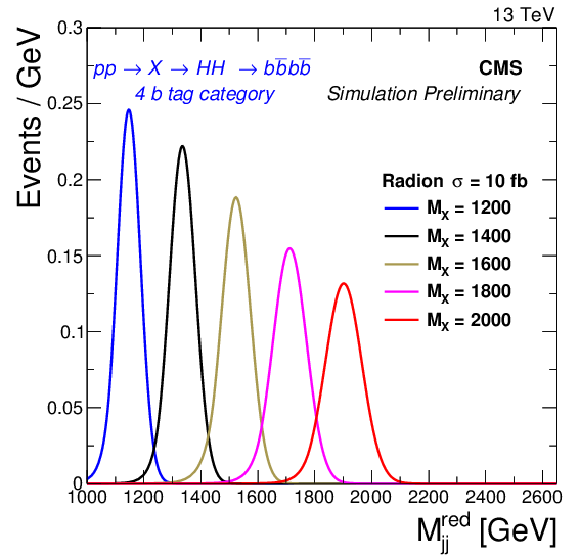
png pdf |
Figure 1:
The reconstructed signal mass distribution, ${M_{\rm jj}^{\rm red}} $, for different generated masses of the radion, modelled using the Crystal Ball function for the 4 b tagged event categories of the subjet b tagger analysis. The distributions are normalized to a signal cross section of 10 fb. |
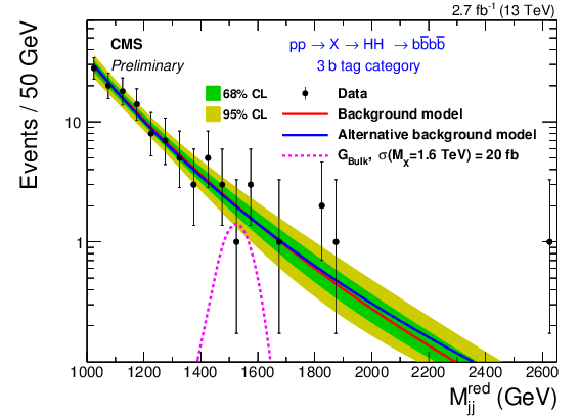
png pdf |
Figure 2-a:
The distribution of ${M_{\rm jj}^{\rm red}} $ for the data (black markers) with a background only fit using the main background model, the levelled-exponential (red line), and an alternative background model, the power law (blue line). The 68% and 95% confidence interval bands on the main background model is given. The expected contribution of the signal for a spin 2 bulk graviton hypothesis is also shown (magenta dotted line). The a (b) figures are for the 3 b (4 b) tagged categories. |
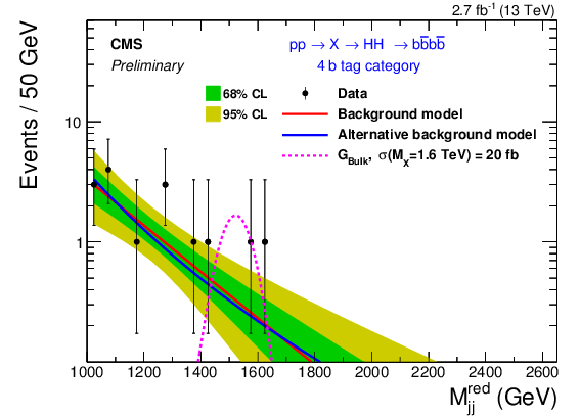
png pdf |
Figure 2-b:
The distribution of ${M_{\rm jj}^{\rm red}} $ for the data (black markers) with a background only fit using the main background model, the levelled-exponential (red line), and an alternative background model, the power law (blue line). The 68% and 95% confidence interval bands on the main background model is given. The expected contribution of the signal for a spin 2 bulk graviton hypothesis is also shown (magenta dotted line). The a (b) figures are for the 3 b (4 b) tagged categories. |

png pdf |
Figure 3-a:
Fit to the $m_{\rm J}$ sideband regions for the pass-fail ratio $R_{p/f}$ along with the fit uncertainties (a). The (b) figure shows the predicted ${M_{\rm jj}^{\rm red}} $ background distribution in the signal region, after applying the ``Alphabet'' method. The statistical and total uncertainties on the predicted background are also shown. The black markers with the error bars are the data. The lower panel shows the difference between the observed and predicted events for each histogram bin, divided by the statistical uncertainty on the observed events. |
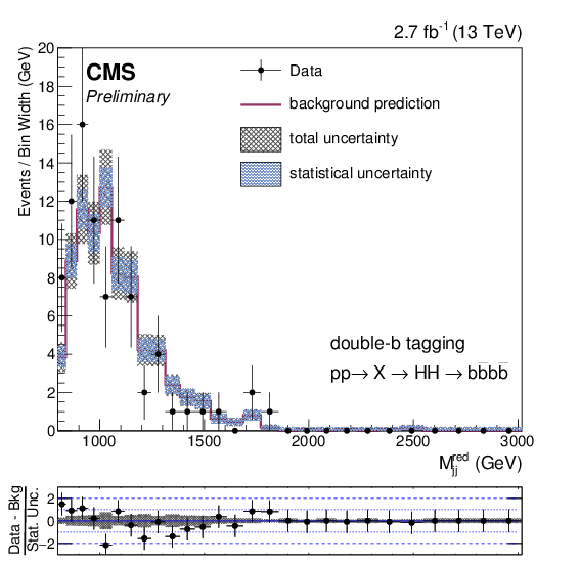
png pdf |
Figure 3-b:
Fit to the $m_{\rm J}$ sideband regions for the pass-fail ratio $R_{p/f}$ along with the fit uncertainties (a). The (b) figure shows the predicted ${M_{\rm jj}^{\rm red}} $ background distribution in the signal region, after applying the ``Alphabet'' method. The statistical and total uncertainties on the predicted background are also shown. The black markers with the error bars are the data. The lower panel shows the difference between the observed and predicted events for each histogram bin, divided by the statistical uncertainty on the observed events. |
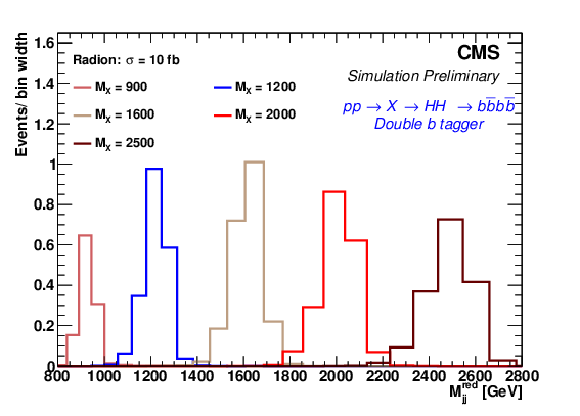
png pdf |
Figure 4:
The reconstructed signal mass distribution, ${M_{\rm jj}^{\rm red}} $, for different generated masses of the radion for the double-b tagger analysis. The distributions are normalized to a signal cross section of 10fb. |
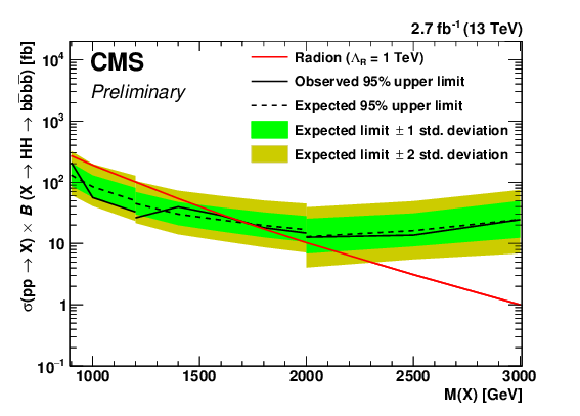
png pdf |
Figure 5-a:
The combined limits for the radion (a) and the bulk graviton (b) models. The double-b tagger analysis is used to set limits for the resonance masses 900-1200 GeV and 2000-3000 GeV, while the subjet b tagger analysis sets limits between 1200-2000 GeV. |

png pdf |
Figure 5-b:
The combined limits for the radion (a) and the bulk graviton (b) models. The double-b tagger analysis is used to set limits for the resonance masses 900-1200 GeV and 2000-3000 GeV, while the subjet b tagger analysis sets limits between 1200-2000 GeV. |
| Tables | |
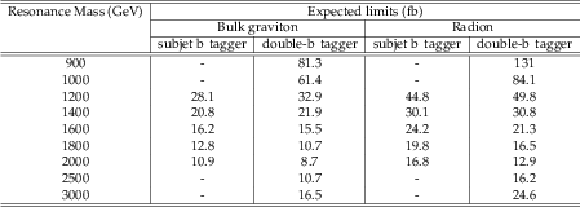
png pdf |
Table 1:
Comparison of expected limits on the production cross section of a resonance decaying to HH for the subjet b tagger and double-b tagger analyses for the bulk graviton and the radion signal hypotheses, for different values of the resonance mass. The results of the double-b tagger analysis are shown over the range 900-3000 GeV, while the results of the subjet b tagger analysis are shown within the mass range 1200-2000 GeV, for reasons explained in Section 1.2. In the mass range where both analyses can be used, the expected limits are compatible. In this range, the final result is quoted for the subjet b tagger analysis, as it has a more precise estimate of the expected limits due to the fact that the uncertainty on the double-b tagging scale factor is larger than that on the subjet b tagging scale factor (Section 6). |
| Summary |
| A search for a new massive resonance decaying to two standard model Higgs bosons is conducted using 2.7 fb$^{-1}$ of CMS pp collision data, collected in 2015 at $ \sqrt{s} = $ 13 TeV. The ${\mathrm{ H }\rightarrow\mathrm{b}\mathrm{ \bar{b} }}$ decay, having the largest branching fraction, is used, resulting in a final state with four b quarks. For the resonance masses considered in this search, the Higgs bosons are highly Lorentz-boosted and the decay products of each Higgs boson are merged into one large-radius jet. Thus the signal events result in a dijet topology, with each Higgs identified as a massive jet with two subjets arising from the hadronization of two b quarks. Two complementary analyses are used to reconstruct such a boosted ${\mathrm{ H }\rightarrow\mathrm{b}\mathrm{ \bar{b} }} $ decay: one using b tagged subjets, and the other using a dedicated double-b tagging algorithm without explicit recourse to subjets. The main background is multijet production through QCD interactions, which is estimated entirely from the data using two different methods: the smoothness test and the ``Alphabet'' methods. The complementarity of the approaches helps to extend the search sensitivity over a wide range of resonance masses. The results are interpreted in terms of narrow radions and bulk gravitons in warped extra-dimensions models. In the absence of any excess in the data above the standard model background, we place upper limits on the production cross section times the branching fraction ${\rm X} \to \mathrm{ H }\mathrm{ H } \to \mathrm{ b \bar{b} }$ for assumed resonance masses between 900 and 3000 GeV. The search excludes a narrow radion (with $\Lambda_{R} =$ 1 TeV) for masses below 1720 GeV at 95% CL. More data is required to exclude a bulk graviton in this mass range for the assumed WED model parameters. |
| Additional Figures | |
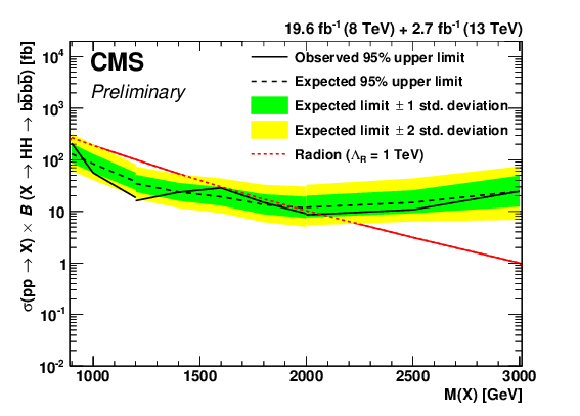
png pdf |
Additional Figure 1:
Final observed (black line), expected (dashed line) 95% CL upper limits on the product of cross section of a narrow resonance decaying to two Higgs bosons using the 13+8 TeV combined data. From 1.2 TeV the limit is evaluated using the Alphabet Method for the background estimation. Note that the limit is presented for the 8 TeV analysis-only before 1.2 TeV. In the range 1.2 TeV to 2 TeV the limit is extracted in the "Smoothness Test" version of the analysis. For resonance masses greater than 2 TeV the limit is taken from the Alphabet Method again, up to 3 TeV. There is no overlap in the transition regions, (Alphabet and Smoothnes Test methods). Theory corresponding to $\Lambda =$ 1 Radion spin-0 resonance hypothesis in the WED scenario is also shown (red line). |
| References | ||||
| 1 | CMS Collaboration | Observation of a new boson at a mass of 125 GeV with the CMS experiment at the LHC | PLB 716 (2012) 30 | CMS-HIG-12-028 1207.7235 |
| 2 | ATLAS Collaboration | Observation of a new particle in the search for the Standard Model Higgs boson with the ATLAS detector at the LHC | PLB 716 (2012) 01 | 1207.7214 |
| 3 | D. de Florian and J. Mazzitelli | Higgs Boson Pair Production at Next-to-Next-to-Leading Order in QCD | PRL 111 (2013) 201801 | |
| 4 | ATLAS Collaboration | Search For Higgs Boson Pair Production in the $ \gamma\gamma b\bar{b} $ Final State using $ pp $ Collision Data at $ \sqrt{s}=8 $ TeV from the ATLAS Detector | PRL 114 (2015) 081802 | 1406.5053 |
| 5 | ATLAS Collaboration | Search for Higgs boson pair production in the $ b\bar{b}b\bar{b} $ final state from pp collisions at $ \sqrt{s} = 8 $ TeV with the ATLAS detector | EPJC 75 (2015) 412 | 1506.00285 |
| 6 | ATLAS Collaboration | Searches for Higgs boson pair production in the $ hh\to bb\tau\tau, \gamma\gamma WW^*, \gamma\gamma bb, bbbb $ channels with the ATLAS detector | PRD 92 (2015) 092004 | 1509.04670 |
| 7 | CMS Collaboration | Searches for heavy Higgs bosons in two-Higgs-doublet models and for $ t→ch $ decay using multilepton and diphoton final states in $ pp $ collisions at 8 TeV | PRD 90 (2014) 112013 | CMS-HIG-13-025 1410.2751 |
| 8 | CMS Collaboration | Search for resonant pair production of Higgs bosons decaying to two bottom quark-antiquark pairs in proton-proton collisions at 8 TeV | PLB 749 (2015) 560 | CMS-HIG-14-013 1503.04114 |
| 9 | CMS Collaboration | Searches for a heavy scalar boson H decaying to a pair of 125 GeV Higgs bosons hh or for a heavy pseudoscalar boson A decaying to Zh, in the final states with $ h \to \tau \tau $ | PLB 755 (2016) 217 | CMS-HIG-14-034 1510.01181 |
| 10 | ATLAS Collaboration | Search for high-mass diboson resonances with boson-tagged jets in proton-proton collisions at $ \sqrt{s}=8 $ TeV with the ATLAS detector | JHEP 12 (2015) 055 | 1506.00962 |
| 11 | ATLAS Collaboration | Search for production of $ WW/WZ $ resonances decaying to a lepton, neutrino and jets in $ pp $ collisions at $ \sqrt{s}=8 $ TeV with the ATLAS detector | EPJC 75 (2015) 209, , [Erratum: \DOI10.1140/epjc/s10052-015-3593-4] | 1503.04677 |
| 12 | ATLAS Collaboration | Search for resonant diboson production in the $ \mathrm {\ell \ell }q\bar{q} $ final state in $ pp $ collisions at $ \sqrt{s} = 8 $ TeV with the ATLAS detector | EPJC 75 (2015) 69 | 1409.6190 |
| 13 | CMS Collaboration | Search for massive resonances in dijet systems containing jets tagged as W or Z boson decays in pp collisions at $ \sqrt{s} $ = 8 TeV | JHEP 08 (2014) 173 | CMS-EXO-12-024 1405.1994 |
| 14 | CMS Collaboration | Search for massive resonances decaying into pairs of boosted bosons in semi-leptonic final states at $ \sqrt{s} = $ 8 TeV | JHEP 08 (2014) 174 | CMS-EXO-13-009 1405.3447 |
| 15 | ATLAS Collaboration | Combination of searches for $ WW $, $ WZ $, and $ ZZ $ resonances in $ pp $ collisions at $ \sqrt{s} = 8 $ TeV with the ATLAS detector | PLB 755 (2016) 285 | 1512.05099 |
| 16 | J. Brehmer et al. | The Diboson Excess: Experimental Situation and Classification of Explanations; A Les Houches Pre-Proceeding | 1512.04357 | |
| 17 | F. Dias et al. | Combination of Run-1 Exotic Searches in Diboson Final States at the LHC | JHEP 04 (2016) 155 | |
| 18 | L. Randall and R. Sundrum | A large mass hierarchy from a small extra dimension | PRL 83 (1999) 3370 | hep-ph/9905221 |
| 19 | G. F. Giudice, R. Rattazzi, and J. D. Wells | Graviscalars from higher dimensional metrics and curvature Higgs mixing | Nucl. Phys. B 595 (2001) 250 | hep-ph/0002178 |
| 20 | W. D. Goldberger and M. B. Wise | Modulus stabilization with bulk fields | PRL 83 (1999) 4922 | hep-ph/9907447 |
| 21 | O. DeWolfe, D. Z. Freedman, S. S. Gubser, and A. Karch | Modeling the fifth dimension with scalars and gravity | PRD 62 (2000) 046008 | hep-th/9909134 |
| 22 | C. Csaki, M. Graesser, L. Randall, and J. Terning | Cosmology of brane models with radion stabilization | PRD 62 (2000) 045015 | hep-ph/9911406 |
| 23 | H. Davoudiasl, J. L. Hewett, and T. G. Rizzo | Phenomenology of the Randall-Sundrum Gauge Hierarchy Model | PRL 84 (2000) 2080 | hep-ph/9909255 |
| 24 | C. Csaki, M. L. Graesser, and G. D. Kribs | Radion dynamics and electroweak physics | PRD 63 (2001) 065002 | hep-th/0008151 |
| 25 | K. Agashe, H. Davoudiasl, G. Perez, and A. Soni | Warped Gravitons at the LHC and Beyond | PRD 76 (2007) 036006 | hep-ph/0701186 |
| 26 | K. Cheung | Phenomenology of radion in Randall-Sundrum scenario | PRD 63 (2001) 056007 | hep-ph/0009232 |
| 27 | M. Gouzevitch et al. | Scale-invariant resonance tagging in multijet events and new physics in Higgs pair production | JHEP 07 (2013) 148 | 1303.6636 |
| 28 | B. Cooper, N. Konstantinidis, L. Lambourne, and D. Wardrope | Boosted $ hh \rightarrow b\bar{b}b\bar{b} $: a new topology in searches for TeV-scale resonances at the LHC | PRD 88 (2013) 114005 | 1307.0407 |
| 29 | J. M. Butterworth, A. R. Davison, M. Rubin, and G. P. Salam | Jet substructure as a new Higgs search channel at the LHC | PRL 100 (2008) 242001 | 0802.2470 |
| 30 | ATLAS and CMS Collaborations | Combined Measurement of the Higgs Boson Mass in $ \mathrm{ p }\mathrm{ p } $ Collisions at $ \sqrt{s}=7 $ and 8 TeV with the ATLAS and CMS Experiments | PRL 114 (2015) 191803 | 1503.07589 |
| 31 | CMS Collaboration | Identification of b-quark Jets at the CMS Experiment in the LHC Run2 Startup | CMS-PAS-BTV-15-001 | CMS-PAS-BTV-15-001 |
| 32 | CMS Collaboration | Identification of double-b quark jets in Boosted Topologies | CMS-PAS-BTV-15-002 | CMS-PAS-BTV-15-002 |
| 33 | J. Alwall et al. | The automated computation of tree-level and next-to-leading order differential cross sections, and their matching to parton shower simulations | JHEP 07 (2014) 079 | 1405.0301 |
| 34 | S. Carrazza, J. I. Latorre, J. Rojo, and G. Watt | A compression algorithm for the combination of PDF sets | EPJC 75 (2015) 474 | 1504.06469 |
| 35 | J. Butterworth et al. | PDF4LHC recommendations for LHC Run II | JPG 43 (2016) 023001 | 1510.03865 |
| 36 | S. Dulat et al. | The CT14 Global Analysis of Quantum Chromodynamics | PRD 93 (2015) 033006 | 1506.07443 |
| 37 | L. A. Harland-Lang, A. D. Martin, P. Motylinski, and R. S. Thorne | Parton distributions in the LHC era: MMHT 2014 PDFs | EPJC 75 (2015) 204 | 1412.3989 |
| 38 | NNPDF Collaboration | Parton distributions for the LHC Run II | JHEP 04 (2015) 040 | 1410.8849 |
| 39 | A. Buckley et al. | LHAPDF6: parton density access in the LHC precision era | EPJC 75 (2015) 132 | 1412.7420 |
| 40 | T. Sjostrand, S. Mrenna, and P. Z. Skands | A Brief Introduction to PYTHIA 8.1 | CPC 178 (2008) 852 | 0710.3820 |
| 41 | J. Allison et al. | Geant4 developments and applications | IEEE Trans. Nucl. Sci. 53 (2006) 270 | |
| 42 | M. Bahr et al. | Herwig++ Physics and Manual | EPJC 58 (2008) 639 | 0803.0883 |
| 43 | CMS Collaboration | Event generator tunes obtained from underlying event and multiparton scattering measurements | EPJC 76 (2016), no. 3, 1 | |
| 44 | A. Oliveira | Gravity particles from Warped Extra Dimensions, a review. Part I - KK Graviton | 1404.0102 | |
| 45 | V. Barger and M. Ishida | Randall-Sundrum Reality at the LHC | PLB 709 (2012) 185 | 1110.6452 |
| 46 | J. Alwall et al. | MadGraph 5 : Going Beyond | JHEP 06 (2011) 128 | 1106.0522 |
| 47 | S. Frixione, P. Nason, and C. Oleari | Matching NLO QCD computations with Parton Shower simulations: the POWHEG method | JHEP 11 (2007) 070 | 0709.2092 |
| 48 | CMS Collaboration | The CMS experiment at the CERN LHC | JINST 3 (2008) S08004 | CMS-00-001 |
| 49 | CMS Collaboration | Particle--Flow Event Reconstruction in CMS and Performance for Jets, Taus, and $ E_{\mathrm{T}}^{\text{miss}} $ | CDS | |
| 50 | CMS Collaboration | Commissioning of the Particle-flow Event Reconstruction with the first LHC collisions recorded in the CMS detector | CDS | |
| 51 | CMS Collaboration | Commissioning of the Particle-Flow Reconstruction in Minimum-Bias and Jet Events from $ \mathrm{ p }\mathrm{ p } $ Collisions at 7 TeV | CDS | |
| 52 | M. Cacciari, G. P. Salam, and G. Soyez | The anti-$ k_t $ jet clustering algorithm | JHEP 04 (2008) 063 | 0802.1189 |
| 53 | M. Dasgupta, A. Fregoso, S. Marzani, and G. P. Salam | Towards an understanding of jet substructure | JHEP 09 (2013) 029 | 1307.0007 |
| 54 | A. J. Larkoski, S. Marzani, G. Soyez, and J. Thaler | Soft Drop | JHEP 05 (2014) 146 | 1402.2657 |
| 55 | S. D. Ellis, C. K. Vermilion, and J. R. Walsh | Recombination Algorithms and Jet Substructure: Pruning as a Tool for Heavy Particle Searches | PRD 81 (2010) 094023 | 0912.0033 |
| 56 | J. Thaler and K. Van Tilburg | Maximizing Boosted Top Identification by Minimizing N-subjettiness | JHEP 02 (2012) 093 | 1108.2701 |
| 57 | M. J. Oreglia | PhD thesis, Stanford University, 1980 SLAC Report SLAC-R-236 | ||
| 58 | CMS Collaboration | CMS Luminosity Measurement for the 2015 Data Taking Period | CMS-PAS-LUM-15-001 | CMS-PAS-LUM-15-001 |
| 59 | CMS Collaboration | Search for massive resonances decaying into pairs of boosted W and Z bosons at $ \sqrt{s} $ = 13 TeV | ||
| 60 | CMS Collaboration | Jet energy scale and resolution in the CMS experiment in pp collisions at 8 TeV | Submitted to JINST | CMS-JME-13-004 1607.03663 |
| 61 | CMS Collaboration | Jet energy scale and resolution performances with 13TeV data | CDS | |
| 62 | A. L. Read | Presentation of search results: the CL$ _s $ technique | JPG 28 (2002) 2693 | |
| 63 | T. Junk | Confidence level computation for combining searches with small statistics | NIMA 434 (1999) 435 | hep-ex/9902006 |

|
Compact Muon Solenoid LHC, CERN |

|

|

|

|

|

|